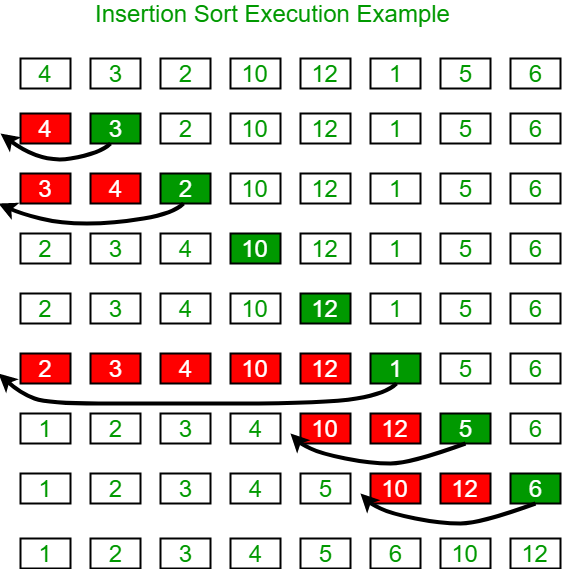Chào ace, bài này chúng ta sẽ tìm hiểu về một trong các thuật toán sắp xếp được sử dụng nhiều trong lập trình và thực tế nhất đó là Insertion Sort, sau đây cafedev sẽ giới thiệu và chia sẻ chi tiết(khái niệm, ứng dụng của nó, code ví dụ, điểm mạnh, điểm yếu…) về Insertion Sort thông qua các phần sau.
Nội dung chính
1. Giới thiệu
Sắp xếp chèn là một thuật toán sắp xếp đơn giản hoạt động tương tự như cách bạn sắp xếp các thẻ chơi trong tay. Mảng hầu như được chia thành một phần được sắp xếp và một phần chưa được sắp xếp. Các giá trị từ phần chưa được sắp xếp được chọn và đặt ở vị trí chính xác trong phần được sắp xếp.
Thuật toán
Để sắp xếp một mảng có kích thước n theo thứ tự tăng dần:
1: Lặp lại từ arr [1] đến arr [n] trên mảng.
2: So sánh phần tử hiện tại với phần tử trước của nó.
3: Nếu phần tử chính nhỏ hơn phần tử trước của nó, hãy so sánh nó với các phần tử trước đó. Di chuyển các phần tử lớn hơn lên một vị trí để tạo khoảng trống cho phần tử được hoán đổi.
Thí dụ:

Một vi dụ khac:
12, 11, 13, 5, 6
Hãy để chúng ta lặp lại i = 1 (phần tử thứ hai của mảng) đến 4 (phần tử cuối cùng của mảng)
i = 1. Vì 11 nhỏ hơn 12 nên di chuyển 12 và chèn 11 vào trước 12
11, 12, 13, 5, 6
i = 2. 13 sẽ vẫn ở vị trí của nó vì tất cả các phần tử trong A [0..I-1] đều nhỏ hơn 13
11, 12, 13, 5, 6
i = 3. 5 sẽ di chuyển về đầu và tất cả các phần tử khác từ 11 đến 13 sẽ di chuyển trước một vị trí so với vị trí hiện tại của chúng.
5, 11, 12, 13, 6
i = 4. 6 sẽ chuyển đến vị trí sau 5, và các phần tử từ 11 đến 13 sẽ di chuyển trước một vị trí so với vị trí hiện tại của chúng.
5, 6, 11, 12, 13
2. Code ví dụ trên nhiều ngôn ngữ lập trình
C++
// C++ program for insertion sort
#include <bits/stdc++.h>
using namespace std;
/* Function to sort an array using insertion sort*/
void insertionSort(int arr[], int n)
{
int i, key, j;
for (i = 1; i < n; i++)
{
key = arr[i];
j = i - 1;
/* Move elements of arr[0..i-1], that are
greater than key, to one position ahead
of their current position */
while (j >= 0 && arr[j] > key)
{
arr[j + 1] = arr[j];
j = j - 1;
}
arr[j + 1] = key;
}
}
// A utility function to print an array of size n
void printArray(int arr[], int n)
{
int i;
for (i = 0; i < n; i++)
cout << arr[i] << " ";
cout << endl;
}
/* Driver code */
int main()
{
int arr[] = { 12, 11, 13, 5, 6 };
int n = sizeof(arr) / sizeof(arr[0]);
insertionSort(arr, n);
printArray(arr, n);
return 0;
} C
// C program for insertion sort
#include <math.h>
#include <stdio.h>
/* Function to sort an array using insertion sort*/
void insertionSort(int arr[], int n)
{
int i, key, j;
for (i = 1; i < n; i++) {
key = arr[i];
j = i - 1;
/* Move elements of arr[0..i-1], that are
greater than key, to one position ahead
of their current position */
while (j >= 0 && arr[j] > key) {
arr[j + 1] = arr[j];
j = j - 1;
}
arr[j + 1] = key;
}
}
// A utility function to print an array of size n
void printArray(int arr[], int n)
{
int i;
for (i = 0; i < n; i++)
printf("%d ", arr[i]);
printf("\n");
}
/* Driver program to test insertion sort */
int main()
{
int arr[] = { 12, 11, 13, 5, 6 };
int n = sizeof(arr) / sizeof(arr[0]);
insertionSort(arr, n);
printArray(arr, n);
return 0;
}
Java
// Java program for implementation of Insertion Sort
class InsertionSort {
/*Function to sort array using insertion sort*/
void sort(int arr[])
{
int n = arr.length;
for (int i = 1; i < n; ++i) {
int key = arr[i];
int j = i - 1;
/* Move elements of arr[0..i-1], that are
greater than key, to one position ahead
of their current position */
while (j >= 0 && arr[j] > key) {
arr[j + 1] = arr[j];
j = j - 1;
}
arr[j + 1] = key;
}
}
/* A utility function to print array of size n*/
static void printArray(int arr[])
{
int n = arr.length;
for (int i = 0; i < n; ++i)
System.out.print(arr[i] + " ");
System.out.println();
}
// Driver method
public static void main(String args[])
{
int arr[] = { 12, 11, 13, 5, 6 };
InsertionSort ob = new InsertionSort();
ob.sort(arr);
printArray(arr);
}
}Python
# Python program for implementation of Insertion Sort
# Function to do insertion sort
def insertionSort(arr):
# Traverse through 1 to len(arr)
for i in range(1, len(arr)):
key = arr[i]
# Move elements of arr[0..i-1], that are
# greater than key, to one position ahead
# of their current position
j = i-1
while j >= 0 and key < arr[j] :
arr[j + 1] = arr[j]
j -= 1
arr[j + 1] = key
# Driver code to test above
arr = [12, 11, 13, 5, 6]
insertionSort(arr)
for i in range(len(arr)):
print ("% d" % arr[i]) C#
// C# program for implementation of Insertion Sort
using System;
class InsertionSort {
// Function to sort array
// using insertion sort
void sort(int[] arr)
{
int n = arr.Length;
for (int i = 1; i < n; ++i) {
int key = arr[i];
int j = i - 1;
// Move elements of arr[0..i-1],
// that are greater than key,
// to one position ahead of
// their current position
while (j >= 0 && arr[j] > key) {
arr[j + 1] = arr[j];
j = j - 1;
}
arr[j + 1] = key;
}
}
// A utility function to print
// array of size n
static void printArray(int[] arr)
{
int n = arr.Length;
for (int i = 0; i < n; ++i)
Console.Write(arr[i] + " ");
Console.Write("\n");
}
// Driver Code
public static void Main()
{
int[] arr = { 12, 11, 13, 5, 6 };
InsertionSort ob = new InsertionSort();
ob.sort(arr);
printArray(arr);
}
} PHP
<?php
// PHP program for insertion sort
// Function to sort an array
// using insertion sort
function insertionSort(&$arr, $n)
{
for ($i = 1; $i < $n; $i++)
{
$key = $arr[$i];
$j = $i-1;
// Move elements of arr[0..i-1],
// that are greater than key, to
// one position ahead of their
// current position
while ($j >= 0 && $arr[$j] > $key)
{
$arr[$j + 1] = $arr[$j];
$j = $j - 1;
}
$arr[$j + 1] = $key;
}
}
// A utility function to
// print an array of size n
function printArray(&$arr, $n)
{
for ($i = 0; $i < $n; $i++)
echo $arr[$i]." ";
echo "\n";
}
// Driver Code
$arr = array(12, 11, 13, 5, 6);
$n = sizeof($arr);
insertionSort($arr, $n);
printArray($arr, $n);
?>
Kết quả
5 6 11 12 133. Độ phức tạp
Độ phức tạp về thời gian: O (n * 2)
Không gian phụ trợ: O (1)
Trường hợp ranh giới: Sắp xếp chèn mất thời gian tối đa để sắp xếp nếu các phần tử được sắp xếp theo thứ tự ngược lại. Và cần thời gian tối thiểu (Thứ tự của n) khi các phần tử đã được sắp xếp.
Mô hình thuật toán: Phương pháp tiếp cận gia tăng
Sắp xếp tại chỗ: Có
Ổn định: Có
Trực tuyến: Có
Công dụng: Sắp xếp chèn được sử dụng khi số lượng phần tử nhỏ. Nó cũng có thể hữu ích khi mảng đầu vào gần như được sắp xếp, chỉ có một số phần tử bị đặt sai vị trí trong một mảng lớn hoàn chỉnh.
4. Binary Insertion Sort là gì?
Chúng ta có thể sử dụng tìm kiếm nhị phân để giảm số lượng so sánh trong sắp xếp chèn thông thường. Binary Insertion Sort sử dụng tìm kiếm nhị phân để tìm vị trí thích hợp để chèn mục đã chọn ở mỗi lần lặp. Trong trường hợp chèn thông thường, việc sắp xếp lấy O (i) (ở lần lặp thứ i). Chúng ta có thể giảm nó thành O (logi) bằng cách sử dụng tìm kiếm nhị phân. Nói chung, thuật toán vẫn có thời gian chạy trong trường hợp xấu nhất là O (n2) vì chuỗi hoán đổi cần thiết cho mỗi lần chèn.
5. Làm thế nào để triển khai sắp xếp chèn cho Danh sách được Liên kết?
- Dưới đây là thuật toán sắp xếp chèn đơn giản cho danh sách liên kết.
1) Tạo danh sách (hoặc kết quả) được sắp xếp trống
2) Duyệt qua danh sách đã cho, thực hiện theo các bước sau cho mọi nút.
…… a) Chèn nút hiện tại theo cách được sắp xếp trong danh sách đã sắp xếp hoặc kết quả.
3) Thay đổi phần đầu của danh sách liên kết đã cho thành phần đầu của danh sách được sắp xếp (hoặc kết quả).
- Code ví dụ trên nhiều ngôn ngữ
C/C++
/* C program for insertion sort on a linked list */
#include<stdio.h>
#include<stdlib.h>
/* Link list node */
struct Node
{
int data;
struct Node* next;
};
// Function to insert a given node in a sorted linked list
void sortedInsert(struct Node**, struct Node*);
// function to sort a singly linked list using insertion sort
void insertionSort(struct Node **head_ref)
{
// Initialize sorted linked list
struct Node *sorted = NULL;
// Traverse the given linked list and insert every
// node to sorted
struct Node *current = *head_ref;
while (current != NULL)
{
// Store next for next iteration
struct Node *next = current->next;
// insert current in sorted linked list
sortedInsert(&sorted, current);
// Update current
current = next;
}
// Update head_ref to point to sorted linked list
*head_ref = sorted;
}
/* function to insert a new_node in a list. Note that this
function expects a pointer to head_ref as this can modify the
head of the input linked list (similar to push())*/
void sortedInsert(struct Node** head_ref, struct Node* new_node)
{
struct Node* current;
/* Special case for the head end */
if (*head_ref == NULL || (*head_ref)->data >= new_node->data)
{
new_node->next = *head_ref;
*head_ref = new_node;
}
else
{
/* Locate the node before the point of insertion */
current = *head_ref;
while (current->next!=NULL &&
current->next->data < new_node->data)
{
current = current->next;
}
new_node->next = current->next;
current->next = new_node;
}
}
/* BELOW FUNCTIONS ARE JUST UTILITY TO TEST sortedInsert */
/* Function to print linked list */
void printList(struct Node *head)
{
struct Node *temp = head;
while(temp != NULL)
{
printf("%d ", temp->data);
temp = temp->next;
}
}
/* A utility function to insert a node at the beginning of linked list */
void push(struct Node** head_ref, int new_data)
{
/* allocate node */
struct Node* new_node = new Node;
/* put in the data */
new_node->data = new_data;
/* link the old list off the new node */
new_node->next = (*head_ref);
/* move the head to point to the new node */
(*head_ref) = new_node;
}
// Driver program to test above functions
int main()
{
struct Node *a = NULL;
push(&a, 5);
push(&a, 20);
push(&a, 4);
push(&a, 3);
push(&a, 30);
printf("Linked List before sorting \n");
printList(a);
insertionSort(&a);
printf("\nLinked List after sorting \n");
printList(a);
return 0;
}
Java
// Java program to sort link list
// using insertion sort
public class LinkedlistIS
{
node head;
node sorted;
class node
{
int val;
node next;
public node(int val)
{
this.val = val;
}
}
void push(int val)
{
/* allocate node */
node newnode = new node(val);
/* link the old list off the new node */
newnode.next = head;
/* move the head to point to the new node */
head = newnode;
}
// function to sort a singly linked list using insertion sort
void insertionSort(node headref)
{
// Initialize sorted linked list
sorted = null;
node current = headref;
// Traverse the given linked list and insert every
// node to sorted
while (current != null)
{
// Store next for next iteration
node next = current.next;
// insert current in sorted linked list
sortedInsert(current);
// Update current
current = next;
}
// Update head_ref to point to sorted linked list
head = sorted;
}
/*
* function to insert a new_node in a list. Note that
* this function expects a pointer to head_ref as this
* can modify the head of the input linked list
* (similar to push())
*/
void sortedInsert(node newnode)
{
/* Special case for the head end */
if (sorted == null || sorted.val >= newnode.val)
{
newnode.next = sorted;
sorted = newnode;
}
else
{
node current = sorted;
/* Locate the node before the point of insertion */
while (current.next != null && current.next.val < newnode.val)
{
current = current.next;
}
newnode.next = current.next;
current.next = newnode;
}
}
/* Function to print linked list */
void printlist(node head)
{
while (head != null)
{
System.out.print(head.val + " ");
head = head.next;
}
}
// Driver program to test above functions
public static void main(String[] args)
{
LinkedlistIS list = new LinkedlistIS();
list.push(5);
list.push(20);
list.push(4);
list.push(3);
list.push(30);
System.out.println("Linked List before Sorting..");
list.printlist(list.head);
list.insertionSort(list.head);
System.out.println("\nLinkedList After sorting");
list.printlist(list.head);
}
} Python
# Pyhton implementation of above algorithm
# Node class
class Node:
# Constructor to initialize the node object
def __init__(self, data):
self.data = data
self.next = None
# function to sort a singly linked list using insertion sort
def insertionSort(head_ref):
# Initialize sorted linked list
sorted = None
# Traverse the given linked list and insert every
# node to sorted
current = head_ref
while (current != None):
# Store next for next iteration
next = current.next
# insert current in sorted linked list
sorted = sortedInsert(sorted, current)
# Update current
current = next
# Update head_ref to point to sorted linked list
head_ref = sorted
return head_ref
# function to insert a new_node in a list. Note that this
# function expects a pointer to head_ref as this can modify the
# head of the input linked list (similar to push())
def sortedInsert(head_ref, new_node):
current = None
# Special case for the head end */
if (head_ref == None or (head_ref).data >= new_node.data):
new_node.next = head_ref
head_ref = new_node
else:
# Locate the node before the point of insertion
current = head_ref
while (current.next != None and
current.next.data < new_node.data):
current = current.next
new_node.next = current.next
current.next = new_node
return head_ref
# BELOW FUNCTIONS ARE JUST UTILITY TO TEST sortedInsert
# Function to print linked list */
def printList(head):
temp = head
while(temp != None):
print( temp.data, end = " ")
temp = temp.next
# A utility function to insert a node
# at the beginning of linked list
def push( head_ref, new_data):
# allocate node
new_node = Node(0)
# put in the data
new_node.data = new_data
# link the old list off the new node
new_node.next = (head_ref)
# move the head to point to the new node
(head_ref) = new_node
return head_ref
# Driver program to test above functions
a = None
a = push(a, 5)
a = push(a, 20)
a = push(a, 4)
a = push(a, 3)
a = push(a, 30)
print("Linked List before sorting ")
printList(a)
a = insertionSort(a)
print("\nLinked List after sorting ")
printList(a) C#
// C# program to sort link list
// using insertion sort
using System;
public class LinkedlistIS
{
public node head;
public node sorted;
public class node
{
public int val;
public node next;
public node(int val)
{
this.val = val;
}
}
void push(int val)
{
/* allocate node */
node newnode = new node(val);
/* link the old list off the new node */
newnode.next = head;
/* move the head to point to the new node */
head = newnode;
}
// function to sort a singly
// linked list using insertion sort
void insertionSort(node headref)
{
// Initialize sorted linked list
sorted = null;
node current = headref;
// Traverse the given
// linked list and insert every
// node to sorted
while (current != null)
{
// Store next for next iteration
node next = current.next;
// insert current in sorted linked list
sortedInsert(current);
// Update current
current = next;
}
// Update head_ref to point to sorted linked list
head = sorted;
}
/*
* function to insert a new_node in a list. Note that
* this function expects a pointer to head_ref as this
* can modify the head of the input linked list
* (similar to push())
*/
void sortedInsert(node newnode)
{
/* Special case for the head end */
if (sorted == null || sorted.val >= newnode.val)
{
newnode.next = sorted;
sorted = newnode;
}
else
{
node current = sorted;
/* Locate the node before the point of insertion */
while (current.next != null &&
current.next.val < newnode.val)
{
current = current.next;
}
newnode.next = current.next;
current.next = newnode;
}
}
/* Function to print linked list */
void printlist(node head)
{
while (head != null)
{
Console.Write(head.val + " ");
head = head.next;
}
}
// Driver code
public static void Main(String[] args)
{
LinkedlistIS list = new LinkedlistIS();
list.push(5);
list.push(20);
list.push(4);
list.push(3);
list.push(30);
Console.WriteLine("Linked List before Sorting..");
list.printlist(list.head);
list.insertionSort(list.head);
Console.WriteLine("\nLinkedList After sorting");
list.printlist(list.head);
}
} Kết quả
Linked List before sorting
30 3 4 20 5
Linked List after sorting
3 4 5 20 30Nguồn và Tài liệu tiếng anh tham khảo:
Tài liệu từ cafedev:
- Full series tự học Cấu trúc dữ liệu và giải thuật từ cơ bản tới nâng cao tại đây nha.
- Ebook về Cấu trúc dữ liệu và giải thuật tại đây.
- Các series tự học lập trình khác
Nếu bạn thấy hay và hữu ích, bạn có thể tham gia các kênh sau của cafedev để nhận được nhiều hơn nữa:
Chào thân ái và quyết thắng!









![[Tự học C++] Số dấu phẩy động(float, double,…) trong C++](https://cafedev.vn/wp-content/uploads/2019/12/cafedevn_c_develoment-100x70.jpg)

